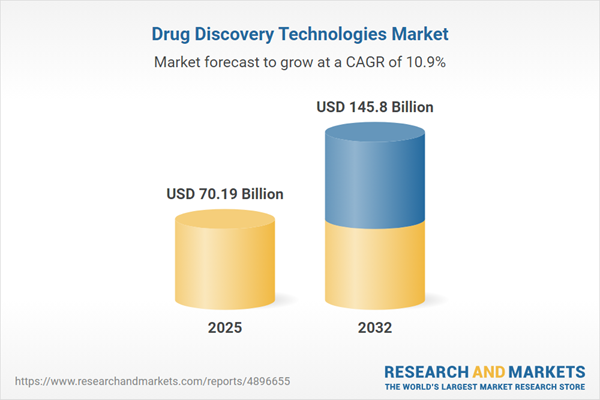Speak directly to the analyst to clarify any post sales queries you may have.
The drug discovery technologies market is entering a period of accelerated transformation, shaped by advanced analytics, data-driven platforms, and changing global supply dynamics. For senior decision-makers, understanding these shifts is key for driving innovation and resilient growth strategies.
Market Snapshot
The Drug Discovery Technologies Market grew from USD 63.50 billion in 2024 to USD 70.19 billion in 2025. It is projected to sustain growth at a CAGR of 10.94%, reaching USD 145.80 billion by 2032. Robust expansion is supported by rapid advancements in artificial intelligence, high throughput screening, and gene editing tools. Market participants are experiencing the strategic impact of shifting trade policies and regulatory frameworks as innovation accelerates across major segments and global regions.
Scope & Segmentation
- Drug Type: Biologic Drugs, Small-Molecule Drugs
- Assay Techniques: Binding Assays, Biochemical Assays, Cell Based Assays, Reporter Gene Assays
- Technology Platforms: Computational Modeling, High Throughput Screening, Nanotechnology, Pharmacogenomics, Structure Based Design
- Application: Biomarker Discovery, Lead Discovery, Preclinical & Clinical Development, Target Identification & Validation, Toxicology Testing
- End User: Academic Institutions, Biotechnology Firms, Pharmaceutical Companies
- Regional Coverage: Americas (United States, Canada, Mexico, Brazil, Argentina, Chile, Colombia, Peru), Europe, Middle East & Africa (United Kingdom, Germany, France, Russia, Italy, Spain, Netherlands, Sweden, Poland, Switzerland, United Arab Emirates, Saudi Arabia, Qatar, Turkey, Israel, South Africa, Nigeria, Egypt, Kenya), Asia-Pacific (China, India, Japan, Australia, South Korea, Indonesia, Thailand, Malaysia, Singapore, Taiwan)
- Companies Profiled: Abbott Laboratories, Amgen, AstraZeneca, Bayer Healthcare, Bio-Rad Laboratories, bioMérieux, Bristol-Myers Squibb, Covaris, Curia Global, Elucidata, Eurofins Advinus, Evotec, F. Hoffmann-La Roche, GE Healthcare, Gilead Sciences, Horiba, Illumina, IQVIA, Luminex (DiaSorin), Merck & Co., Novartis, Pfizer, PIRAMAL PHARMA, Randox Laboratories, Revolution Medicines, Sanofi, Sygnature Discovery, Syngene International, Thermo Fisher Scientific, VWR International, WuXi AppTec
Key Takeaways
- The adoption of artificial intelligence and machine learning is streamlining drug discovery by enhancing predictive accuracy and decision-making across core processes.
- CRISPR, gene editing, and organ-on-a-chip platforms are introducing new levels of precision and mechanistic insight, contributing to safer and more targeted therapies.
- Trade policy adjustments, including new tariffs on key research consumables, are compelling organizations to rethink sourcing, prioritize domestic suppliers, and strengthen procurement resiliency.
- Regulatory frameworks are evolving to enable faster approvals for innovative therapies, prompting competitive positioning through strategic alliances with academic and technology partners.
- End users—ranging from academia to biotech and pharmaceutical firms—dictate diverse investment patterns, with each segment prioritizing different aspects of technology and application.
- Regional differences in infrastructure maturity, funding, and adoption rates require tailored approaches to site selection, partnership formation, and regulatory alignment.
Tariff Impact
Recent tariff changes have created significant impacts across the global drug discovery technology supply chain. Increased duties on imported inputs are reshaping vendor negotiation strategies and encouraging a pivot toward local manufacturing and diversified suppliers. Organizations are reallocating R&D budgets to anticipate cost fluctuations, and some are investing in vertical integration to secure essential resources. Building resilient supplier networks is now critical for both cost management and uninterrupted research operations.
Methodology & Data Sources
This report utilizes a systematic approach combining extensive secondary research with expert-led interviews, quantitative data validation, and advanced statistical analysis. The research draws on peer-reviewed publications, industry white papers, patent filings, regulatory updates, and structured interviews with industry leaders and regulatory specialists to ensure robust, bias-minimized insight generation.
Why This Report Matters
- Equips senior leaders with data-driven insights to prioritize R&D investments and optimize procurement strategies amid shifting regulatory and supply chain conditions.
- Highlights emerging trends in technology and regional adoption, enabling evidence-based decision-making for market expansion or partnership selection.
- Provides comprehensive segmentation analysis and profiles of key industry players for competitive benchmarking.
Conclusion
This report offers clear, actionable intelligence for navigating the complexities of the drug discovery technologies market. By leveraging its insights, decision-makers can foster innovation, manage risk, and strengthen competitive advantage in a rapidly evolving sector.
Additional Product Information:
- Purchase of this report includes 1 year online access with quarterly updates.
- This report can be updated on request. Please contact our Customer Experience team using the Ask a Question widget on our website.
Table of Contents
3. Executive Summary
4. Market Overview
7. Cumulative Impact of Artificial Intelligence 2025
Companies Mentioned
The companies profiled in this Drug Discovery Technologies market report include:- Abbott Laboratories, Inc.
- Amgen Inc.
- AstraZeneca PLC
- Bayer Healthcare AG
- Bio-Rad Laboratories, Inc.
- bioMérieux SA
- Bristol-Myers Squibb Company
- Covaris, LLC
- Curia Global, Inc.
- Elucidata Corporation
- Eurofins Advinus Private Limited
- Evotec SE
- F. Hoffmann-La Roche Ltd.
- GE Healthcare Ltd.
- Gilead Sciences, Inc.
- Horiba, Ltd.
- Illumina, Inc.
- IQVIA Inc.
- Luminex Corporation by DiaSorin Group
- Merck & Co., Inc.
- Novartis AG
- Pfizer Inc.
- PIRAMAL PHARMA LIMITED
- Randox Laboratories Ltd.
- Revolution Medicines, Inc.
- Sanofi S.A.
- Sygnature Discovery Limited
- Syngene International Limited
- Thermo FIsher Scientific Inc.
- VWR International LLC
- WuXi AppTec Co., Ltd.
Table Information
| Report Attribute | Details |
|---|---|
| No. of Pages | 182 |
| Published | November 2025 |
| Forecast Period | 2025 - 2032 |
| Estimated Market Value ( USD | $ 70.19 Billion |
| Forecasted Market Value ( USD | $ 145.8 Billion |
| Compound Annual Growth Rate | 10.9% |
| Regions Covered | Global |
| No. of Companies Mentioned | 32 |









